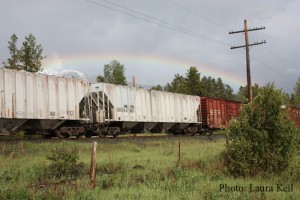
Living in a small town near a rail track, it’s hard not to feel the palpable horror of those in Lac Megantic two weeks ago.
Fourty-two people have already been counted dead, and at least 8 more are missing. In a town of 6,000 people, I can imagine, with a pit in my stomach, residents’ dread knowing that friends and acquaintances are gone forever.
One month ago, the Goat published a feature article on the dangers of transporting oil by rail and the likelihood of it coming through the Robson Valley. We referenced several derailments that had spilled oil. Lac Megantic is not isolated as far as derailments, though it is certainly the most horrific yet.
When we published our article last month, we only found a few recent articles on oil transportation by rail and about the huge increase in the past couple years in North America.
Since the explosion at Lac-Megantic the topic has taken on a new degree of newsworthiness. No less, for the Robson Valley. The explosion in that town flattened an area roughly 200 square metres. That’s big enough to obliterate 1-3 blocks of homes and businesses in Valemount or McBride.
While no oil currently flows through the Robson Valley by train, many other flammable chemicals do. And as we mentioned in our article last month, the prospect of oil coming through Northern BC is likely, especially in light of delays with pipeline construction.
It was obviously a fluke accident that caused the derailment in Lac Megantic. You can’t build policy on fluke accidents. But you can build policy to ensure a better degree of safety for transporting dangerous goods.
In our last article, we brought up concerns about the DOT-111 tankers and their safety ratings, as well as the lack of consultation that occurs in communities where oil is being transported. Unlike pipelines, communities have no say over what races by on the tracks. The countless communities that built up around the railroad are not connected to it in a way they once were. The railroad is historical, grandfathered-in, a pillar of industry not to be touched or critiqued. Even CN Rail, once a Canadian company, is now a US-based corporation. Who now owns the track?
The government needs to enact regulation that will provide a level playing field for all rail companies, so no one company is merely volunteering to spend money on expensive safety upgrades.
We as Canadians need to support our federal, provincial and municipal governments to demand better safety ratings on rail cars transporting hazardous goods. We need to seriously consider the construction of berms or barricades close to busy residential and commercial areas to contain derailed cars should an accident occur. We should also demand that trains holding dangerous goods not be left unattended.
The movement of goods will not slow down in our lifetimes. We already count trains with two engines, chugging 100 cars through the mountains to a coastal destination.
Local CN crews are given memos about what is contained in each car. Valemount recently created an Emergency Planning Committee. Wouldn’t it be great if the information about the contents of rail cars was logged in a file accessible by first responders?
In Canada’s race for a better quality of life, we must carefully balance energy-use with our need for hazardous industry close to our communities. We must also consider our energy consumption as directly related to the need for these dangers, unless we lobby for significant clean energy sources such as geothermal and widespread energy conservation.
The rail companies have touted that 99.9 per cent of all dangerous rail cargo reaches its destination safely. But 0.1 per cent of a billion (litres, wilderness, lives, you name it) is still 1 million.
As cargo grows, the percentage error may not – but the risk to our communities certainly will.
By: Laura Keil



